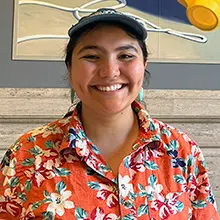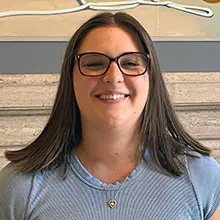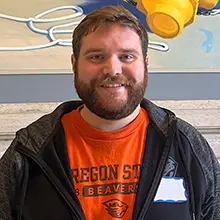
Dakota Baxter
Physical Oceanography major, Millersville University
CEOAS mentor: Peder Nelson
Quantifying Coastal Mapping & Vulnerability Through Multi-Platform Validation by Integrating Citizen Science, Geodetic GPS, and Satellite Observations at South Beach, Oregon
Coastal erosion in the Pacific Northwest is driven by complex interactions between wave energy, tidal forces, and dynamic shoreline processes. However, current satellite-derived shoreline (SDS) models exhibit significant inaccuracies (±15m) due to uncalibrated tidal artifacts and insufficient ground validation, limiting their utility for coastal management. This study enhances Satellite Derived Shoreline (SDS) accuracy at South Beach, Oregon, by integrating citizen science observations (NASA GLOBE Observer), high-precision geodetic GPS surveys (±0.8 cm vertical accuracy), NOAA tidal and wave metrics, bathymetric analysis, and historical Landscape Change Monitor System (LCMS) records. Our multi-platform validation framework achieved a 62% reduction in positional errors, improving SDS accuracy to less than ±5 meters across 89% of transects surveyed through tidal-stage-aware corrections. Key findings reveal that 72% of erosion sites correlate with steep submarine slopes (1m:15m gradient), where wave energy amplification factors reach 3.2×. These results provide high-resolution validation datasets essential for training AI models in coastal geomorphology, while a public-facing StoryMap poster translates findings for adaptive management. The study establishes a replicable framework for quantifying climate-amplified coastal vulnerability and advances dynamic classification of "always," "sometimes," and "never" wet zones—critical for predicting future shoreline change under rising sea levels.

Alder Chu
Oceanography major, Oregon State University
CEOAS mentor: Greg Wilson
Experimental validation of a theory for the onset and strength of wave breaking
The processes that lead to the onset of wave breaking in the nearshore are not well understood. A theory to parameterize the onset of wave breaking, using wave speed and water velocity, was tested using existing experimental close-range airborne remote sensing data from previous field work. Our goal was to obtain data from a narrow region around the fast-moving (~5 m/s) wave crest, and at the exact instant of wave breaking onset, two critical requirements for validating the theory. Water velocity data was extracted from aerial video data using particle image velocimetry technique. Wave speed was extracted from aerial lidar data, and a crest-following technique was developed to identify the elevation and water velocity in the crest of the wave as it moved. Preliminary results show the dataset includes adequate coverage and resolution to track waves near and just outside the wave break point, demonstrating for the first time how this technique can be used to obtain breaking wave data in real-world field conditions. Further work is needed to refine the crest-following technique to reduce uncertainty, to apply the technique to more waves throughout the extent of the data, and to compare surface velocities extracted from video data with in-situ velocity measurements.

Suzanne De Visser
Environmental Science major, Oregon State University
CEOAS mentor: Alyssa Shiel
Evaluating the impact of lead-sheathed telecom cables on urban lead exposure in a changing climate
Lead (Pb) is a toxic metal that has been widely used across the United States and repercussions of its use continue to be observed. While lead has decreased in use, understanding the effects of lead found throughout the environment is critical due to its impacts on child development and overall human health. This includes studying how lead-sheathed telecommunication cables left in urban soils impact the environment in Corvallis, Oregon, and how climate change affects the remobilization of lead. To do so, samples will be measured for lead concentration and the results compared to similar samples previously collected from various areas across Corvallis over the last year. Samples will include sitepoints below lead cables, sitepoints across the street from lead cables, and sitepoints for urban background data. The data collected will aid in assessing the amount of lead present in soil and moss, and can be applied to evaluate how changing climate conditions affect lead remobilization.

Leda Dowd
Engineering Geology major, University of California, Los Angeles
CEOAS mentor: Peder Nelson
Monitoring Land Cover and Landslides: Integrating Citizen Science and Remote Sensing from the Oregon Coast to Corvallis
Earth’s surface is changing more drastically than ever; thus, land cover data is critical for monitoring this change and influencing decision makers in fields ranging from geography to disaster response to sustainable resource management. Advances in satellite imagery and machine learning have enabled the creation of global land cover maps, which classify world surface cover based on multispectral imagery, and are revolutionizing how we monitor our planet. However, these models contain gaps and inaccuracies and often produce conflicting results. Our research focuses on creating reference data to assess the accuracy and applicability of these datasets. This study compares three recent global land cover maps, ESA WorldCover, Google and World Resources Institute's Dynamic World and ESRI Land Use/ Land Cover, across three distinct environments in Oregon: coastal, (Newport), forested, (Philomath), and urban (Corvallis). Reference data were generated from 37 Primary sampling units within 3 x 3 km grids, using in situ directional photographs and high-resolution satellite imagery. Root mean squared error values were lowest for World Cover (11.97%), followed by Dynamic World (13.14%) and ESRI Land Cover (14.80%). The models performed well in large homogeneous areas, but were less accurate over smaller, heterogeneous regions. Additional analysis was conducted at 12 coastal sites with known or suspected landslide activity. Discrepancies among ground photos, Landsat spectral times series, and land cover classifications may be indicative of landslide occurrence. However, further research is needed to identify the specific agents of change responsible for these discrepancies, and to determine how citizen science observations can improve landslide and land cover databases.

Joseph Egan
Physics major, Lewis University
CEOAS mentors: Kristen Buck and Salvatore Caprara
Investigating the Speciation of Preformed Nickel (Ni) in the Southern Ocean
Nickel is an important trace metal micronutrient for phytoplankton. In seawater, dissolved nickel exists in both inorganic and organic forms that define nickel bioavailability to phytoplankton. However, this chemical speciation of dissolved nickel in seawater is poorly characterized. The first depth profiles of nickel speciation, conducted off the West Florida Shelf and in the subtropical North Atlantic near Bermuda, revealed a conspicuous increase in organically complexed nickel in Antarctic Intermediate Waters (AAIW), suggesting distinct speciation of preformed dissolved nickel in Southern Ocean water masses. Here, we present the first measurements of dissolved nickel speciation from surface waters of the Antarctic Circumpolar Current in the Drake Passage, downstream from where AAIW is formed. Applying the same competitive ligand exchange-adsorptive cathodic stripping voltammetry method as utilized for the previous depth profiles, and measuring inorganic forms of nickel as labile dissolved nickel concentrations, the organically complexed nickel concentration was determined by difference from total dissolved nickel concentrations. Labile dissolved nickel concentration measurements were conducted on archived shipboard incubation samples exploring the role of phytoplankton growth on nickel speciation in surface waters of the Southern Ocean. Results showed that organic nickel concentrations in incubation samples even prior to significant phytoplankton growth were similar to the concentrations measured in the AAIW of the North Atlantic, demonstrating an organic nickel concentration larger than any global water mass previously studied. Such results are consistent with a distinct speciation of preformed dissolved nickel in Southern Ocean water masses whose mechanism of origin remains unknown.

Thomas Freiling
Physics major, University of California, Davis
CEOAS mentor: James Lerczak
Analyzing Salinity Variability and Developing Salinity Forecast Models for the Yaquina Bay Estuary
Estuaries are dynamic coastal systems where freshwater from rivers mixes with saltwater from the ocean, creating complex salinity patterns that vary across space and time. This project investigates how salinity variability in the Yaquina Bay Estuary relates to river discharge and tides, the primary drivers of salinity variability in most estuaries. Understanding these relationships is essential for predicting salinity changes that impact ecosystems. This study is also motivated by the need to forecast salinity in commercial fishing ports and ocean water intakes at marine laboratories. Time-series data of salinity and sea level from Yaquina Bay Estuary and of river discharge from Alsea River, collected by other groups, were downloaded and processed. Salinity data were filtered using low-pass and high-pass filters to separate the variability driven by river discharge and spring/neap cycles in tidal amplitude from those primarily driven by tidal fluctuations, with periods of approximately 12 and 24 hours. Correlation analysis was then applied to assess how strongly salinity is related to river discharge and tides, and to determine whether changes in these drivers lead to increases or decreases in salinity. These methods provide insight into the primary drivers of salinity variability and support the development of a forecasting model. This study compares the skill in empirical models and a Long Short-Term Memory model (LSTM; a type of machine learning model), to forecast both low-pass salinity and total salinity variability. The ultimate goal of this project is to build and assess salinity forecast models specifically for use by the Newport Commercial Marina and the Hatfield Marine Science Center ocean water intake.

Annalise Gregory
Geology major, Oregon State University
CEOAS mentor: Christo Buizert
A Basin-by-Basin Approach to Understanding Antarctic Ice Sheet Hysteresis Through the Plio-Pleistocene
The geologic record provides a unique opportunity to study the sensitivity of ice sheets and global sea level to climate change. In particular, past warm periods such as the Pliocene may be an analogue for changes expected in the future. Antarctic ice volume during the Pliocene is thought to have been smaller than today, with reduced ice extent and volume in West Antarctica and possibly the Wilkes and Aurora basins of East Antarctica. The Pliocene has historically been thought of as having much higher CO2 levels than pre-industrial conditions, providing a straightforward explanation for such reduced ice volume. However, recent ice core research indicates that the CO2 and CH4 levels of the time were likely very similar to what they were pre-industrial, posing a dilemma. How can we explain a greatly reduced global ice volume without a change in radiative forcing to drive it? Here we explore the idea that ice sheet hysteresis behavior can resolve this apparent discrepancy.
Previous studies have modeled the hysteresis experienced by Antarctica as a whole when it is subjected to a wide range of temperatures; however, how individual basins (such as the Aurora and the Wilkes) experience this, as well as how they have experienced it in Earth’s history, has yet to be investigated. In this study, we utilize ice sheet simulations generated from previous modeling study. We then divide the ice sheet down into smaller packages defined by Antarctic drainage basins to understand how these different basins experience hysteresis under temperature forcing. We then use past climate reconstructions extending into the mid-Zanclean age of the Pliocene, to determine possible pathways of past Antarctic glaciation, and to determine on which hysteresis branch (“retreat” or “regrowth”) these basins are at a given point in time. We find that several Antarctic sectors (including Wilkes, Aurora and West Antarctica) experience bistability at temperatures close to pre-industrial. Ice volume in these sectors therefore depends strongly on the climate and ice sheet history, and its absence during the Pliocene can be explained via hysteresis rather than relatively high concentrations of CO2. If this proves to be the case, this can be used to inform key assumptions required for the further refinement of climate models.

Kasey Ingram
Columbia River Intertribal Fish Commission Tribal Interns (funded by CRITFC & NANOOS)
Integrative Biology – Marine Biology, Oregon State University
Mentors: Jack Barth and Jace Marquardt (CEOAS), Charles Seaton and Rosie Gradoville (CRITFC)
Understanding and Monitoring the Relationship Between Upwelling and Nearshore Hypoxia in the Pacific Northwest
Upwelling, a process by which cold, salty, nutrient-rich waters move from the deep ocean to shallower waters, is a commonly occurring process within the Pacific Northwest which fuels the region’s exceptionally productive marine ecosystems. However, upwelled waters are also low in oxygen and when excessive upwelling happens, hypoxic or anoxic events can occur which can be defined as periods when areas of the ocean have little or no oxygen. Consequently, these events effectively suffocate marine life, harming marine ecosystems and communities that rely on them. Therefore, longstanding efforts to study and monitor ocean conditions and hypoxic or anoxic events using data from off and nearshore oceanographic instruments, specifically gliders and moorings, allows for a more holistic understanding and better prediction of hypoxic and anoxic events. Using Jupyter Notebooks, Python, and publicly accessible data from organizations like the Columbia River Inter-Tribal Fish Commission, the Ocean Observatories Initiative, and the Northwest Association of Networked Ocean Observing Systems, graphs that visualize the change in and relationship between various marine conditions like dissolved oxygen, density, depth, latitude, longitude, and time were made. Graphed mooring and glider data from 2018 revealed that dissolved oxygen levels in upwelled water decreased between the glider observations in late May and early June and the later mooring observations in late June and early July. This decrease in dissolved oxygen results from upwelled nitrate causing phytoplankton blooms that lead to decay and respiration which lowers the oxygen content of water at a depth of 35m near the mouth of the Columbia River. Continued research may investigate how upwelling and dissolved oxygen content changes throughout a year or across years.

Yvette Lin
Earth System Science major, University of California, Irvine
CEOAS mentor: Amrapalli Garanaik
Modeling the diurnal warm layer under variable solar radiation and wind stress
The diurnal variability of solar radiation and wind plays a central role in shaping the structure and dynamics of the upper ocean. A key response to this variability is the formation of the diurnal warm layer (DWL), a shallow, stratified layer that emerges under strong daytime heating and weak wind conditions. While equatorial regions are often favored in studies of DWL evolution because of their strong solar heat fluxes, less is known about DWL dynamics at higher latitudes, where wind, Coriolis force, and mesoscale effects become more influential. Using Oceananigans.jl, a GPU-accelerated, high-resolution large-eddy simulation (LES) model, daily cycles of solar radiation and wind-forcing and their influence on the formation and breakdown of the DWL are studied. Nonlinear couplings between stratification and turbulence are modeled and analyzed using idealized simulations on OSU’s high-performance computing cluster (HPC) that vary the intensity and timing of surface ocean fluxes under realistic diurnal conditions. Simulation results reveal how low wind speeds (2 𝑚𝑠−1) and strong solar heat fluxes lead to intense stratification and significant DWL presence. Moderate (5 𝑚𝑠−1) to high (8 𝑚𝑠−1) wind speeds and strong solar heat fluxes 21 result in more convective mixing, the formation of a deeper mixed layer, and the persistence of the DWL beyond a 24-hour period. Project results offer key insight into the dynamics of wind- and heat-driven upper ocean mixing under controlled conditions and to improve the parameterization 24 of diurnal air-sea interactions in large-scale climate models.

Ella McKee
Physics major, Fort Hays State University
CEOAS mentors: Joseph Stoner, Deepa Dwyer, Sami Cargill
Are there major differences between two sites in Baffin Bay? A geomagnetic study of the gravity cores 97 and 98 collected from the AR76-01
Paleomagnetic studies offer critical insight into Earth’s magnetic field behavior and are particularly valuable in high-latitude regions where data remains sparse. During the AR2307 expedition aboard the R/V Neil Armstrong, two marine sediment gravity cores (97GC and 98GC) were retrieved from adjacent sites in Baffin Bay, off the coast of western Greenland. A series of paleomagnetic analyses were conducted to characterize and compare the paleomagnetic signal and magnetic properties between the two sites. U-channel samples were extracted following core splitting and cleaning and subjected to measurements of natural remanent magnetization and anhysteretic remanent magnetization using a superconducting quantum interference device magnetometer. Initial results revealed several consistent paleomagnetic features across both cores, as well as localized differences in intensity and directional trends. Notably, natural remanent magnetization data from three core intervals showed unusual behavior during demagnetization: magnetic minerals appeared to demagnetize and then remagnetize during the final demagnetization steps. While the cause of this behavior remains uncertain, it may indicate the presence of a distinct magnetic mineral assemblage. This study contributes to expanding the high-resolution paleomagnetic record in polar regions and supports further investigation into regional geomagnetic variations in Baffin Bay.

Sebastian Moreno-Comstock
Applied Physics major, Tufts University
CEOAS mentor: Amrapalli Garanaik
Langmuir Turbulence and Lagrangian Particle Tracking in the Upper Ocean Mixed Layer
Upper ocean mixing processes influence energetics in the mixed layer and strongly influence the motion of neutrally buoyant particles such as fluid parcels. Langmuir turbulence (LT) is a unique mixing process that occurs when surface waves and wind-driven current interact, creating counter-rotating vortices (called Langmuir cells) with axes that align with the direction of wind. Tracking particles in the presence of LT will help better understand the scales and energetics of mixing in the upper ocean and expand our understanding of a critical process that affects global climate and weather patterns. Lagrangian particle tracking was implemented into medium-resolution, three-dimensional large-eddy simulations of LT to collect data on particle position, vertical velocity, and temperature for a range of parameter spaces including surface forcing, mixed layer depth, and background stratification. Analysis of particle paths and scatter plots determined how LT and other mixing processes influence their motion, and comparisons between tracer profiles of Eulerian and Lagrangian data assess the accuracy of Lagrangian particles in capturing energetics.

Sophia Nowers
Agricultural Sciences major, Oregon State University
CEOAS mentors: Aaron Wolf, Henry Pitts
Ecological Tradeoffs in Agricultural Wetlands: The Management of Flood Irrigated Grass-Hay Systems in the Intermountain West for Waterbirds and Ranching
Flood-irrigated grass-hay wetlands in the Intermountain West play a vital dual role in supporting both migratory waterbird populations and cattle ranching in an increasingly water-limited landscape. In the Chewaucan Basin of southcentral Oregon, flood-irrigation sustains wetland function and forage production, but management decisions--such as when and how to irrigate, hay, and graze--can create both conflicts and areas of overlap between agricultural and ecological goals. This thesis conducts a narrative literature review to assess how these practices—such as irrigation timing, haying, and grazing—affect waterbirds, habitat quality, and forage productivity. Drawing on case studies from across the region and western North America, the review synthesizes existing research on the ecological impacts of haying and grazing, flood irrigation hydrology, waterbird ecology, and agricultural practices. Aligning waterbird conservation with working wetlands, flood-irrigation practices mimic the hydrology of natural wetlands and maintains wetlands later into the year. Fields with high vegetative diversity and complex topography provide habitat and forage to many waterbird species but haying can pose an ecological trap to nesting waterbirds. Balancing agricultural and ecological management goals on flood-irrigated wetlands in the Chewaucan Basin and the Intermountain West remains a delicate balancing act that is highly context dependent, one that is more urgent as climate change warms and dries the region and increases precipitation variability.

Zecheriah Webb
Columbia River Intertribal Fish Commission Tribal Interns (funded by CRITFC & NANOOS)
Marine Biology major, University of Oregon
CEOAS mentors: Jack Barth and Jace Marquardt (CEOAS), Charles Seaton and Rosie Gradoville (CRITFC)
Vertical and Alongshore Variability in Hypoxia and Salinity Influenced by the Columbia River Plume and Upwelling off the U.S. Pacific Northwest
Seasonal coastal upwelling and river plume dynamics significantly influence dissolved oxygen and salinity patterns along the Pacific Northwest shelf, creating conditions that are favorable for ocean acidification and hypoxia. Vertical oxygen and salinity patterns during the 2018 upwelling season were analyzed using multi-depth data from three moored buoys: the Washington Shelf Surface Mooring (CE07SHSM), the Oregon Shelf Surface Mooring (CE02SHSM), and the Columbia Plume (Saturn II) mooring near Astoria, Oregon. The plume can extend tens to hundreds of kilometers offshore and northward along the Washington shelf, occasionally reaching depths of ~25 m near Grays Harbor, where low-salinity pulses coincide with downwelling-favorable winds. Results show these frequent hypoxic events in near-bottom waters during late spring and summer, coinciding with intensified upwelling. This time spanned from July to October 2018, capturing the spring freshet, peak upwelling, and late-season relaxation from storms. Dissolved oxygen and salinity were monitored at multiple depths to determine the start, severity, and vertical spread of low-oxygen events. These patterns in oxygen variability were examined with respect to wind forcing and river discharge to gauge how stratification may inhibit vertical mixing and influence hypoxia development. Frequent hypoxic events in near-bottom waters coincided with intensified upwelling during late spring and summer, while plume-driven stratification appeared to influence vertical oxygen structure. These observations provide insight into how river plume dynamics and upwelling interact to shape oxygen variability in the northern California Current, informing regional ecosystem monitoring and management.

Samuel Whitmire
Physics major, Oregon State University
CEOAS mentors: Joseph Stoner, Deepa Dwyer, Sami Cargill
The B in Baffin Bay: Analysis of the Behavior of Earth’s Magnetic Field in the North Atlantic Over Time
Earth’s magnetic field, intrinsically produced by a conductive liquid metal geodynamo process in its outer core layer, is responsible for beautiful auroras, the function of magnetic compasses, and protecting all life on Earth from harmful cosmic radiation, among other things; it has also historically fluctuated, sometimes drastically, in intensity, polarity, and orientation. These ever-changing qualities of the geomagnetic field can naturally be recorded in rocks and sediments deposited on Earth’s surface over time and can be observed and measured using specific paleomagnetic tools and methods. Some of the most drastic of these field variations, known as geomagnetic excursions or reversals, take place intermittently throughout Earth’s history and can be observed in optimal circumstances and studied. Observations from samples all over the world help constrain whether such events are global or perhaps, confined to more localized areas which could provide information on geomagnetic processes and the earth system implications of such events. Through analysis of sediment core HE0006-4-2PC, collected on the USCGC Healy in Baffin Bay, we were able to construct a high-resolution paleomagnetic record at this site. We observed at least one specific candidate for a late Pleistocene excursion event, as well as other periods of low intensity and larger than characteristic patterns of changes in the recorded field orientation. These observations are being evaluated for robustness and if considered geomagnetic, will allow us to compare and stratigraphically link our core to others from the area, gaining further insight into the nature of these events and the time in which these sediments were deposited, and lend to a more robust understanding of geomagnetic field behavior locally and globally at those times.

Amanda Williams
Marine Science major, Samford University
CEOAS mentors: Julia Fontana, Kim Bernard
Zooplankton Communities in New Zealand: Observing Distribution and Depth
The increasing amount of marine heatwave events in New Zealand waters can lead to unpredictable changes in the abundance and distribution of crucial zooplankton species and shape future interactions with their predators. Monitoring the krill Nyctiphanes australis within the South Taranaki Bight (STB) region of New Zealand will help inform the presence and distribution of this key species, which presently needs more detailed documentation. As a part of the Synthesis of Acoustics, Physiology, Prey, and Habitat In a Rapidly changing Environment (SAPPHIRE) project, these data will help validate usage of echosounders in detecting N. australis distribution in future research. Footage of the water column, along with CTD and echosounder data, were collected in the austral summer of 2025, and observations were manually created referencing the recordings. CTD and video data were combined in RStudio to determine the vertical depth distribution of krill and other zooplankton species and to perform statistical analysis. The results of the analysis indicate that there is a positive association between the aphotic zone and krill presence, as well as between the photic zone and salps. Additionally, krill distribution seems to fluctuate in accordance with typical diel vertical migration patterns
Return to Summer Research Internships for Undergraduates